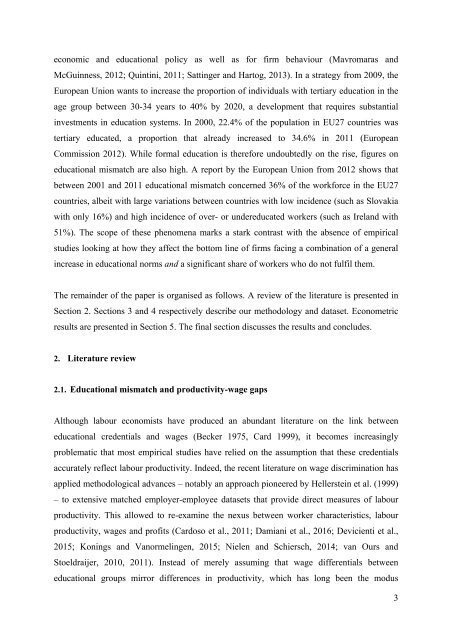CEB Working Paper
240798&r=lma
240798&r=lma
Create successful ePaper yourself
Turn your PDF publications into a flip-book with our unique Google optimized e-Paper software.
economic and educational policy as well as for firm behaviour (Mavromaras and<br />
McGuinness, 2012; Quintini, 2011; Sattinger and Hartog, 2013). In a strategy from 2009, the<br />
European Union wants to increase the proportion of individuals with tertiary education in the<br />
age group between 30-34 years to 40% by 2020, a development that requires substantial<br />
investments in education systems. In 2000, 22.4% of the population in EU27 countries was<br />
tertiary educated, a proportion that already increased to 34.6% in 2011 (European<br />
Commission 2012). While formal education is therefore undoubtedly on the rise, figures on<br />
educational mismatch are also high. A report by the European Union from 2012 shows that<br />
between 2001 and 2011 educational mismatch concerned 36% of the workforce in the EU27<br />
countries, albeit with large variations between countries with low incidence (such as Slovakia<br />
with only 16%) and high incidence of over- or undereducated workers (such as Ireland with<br />
51%). The scope of these phenomena marks a stark contrast with the absence of empirical<br />
studies looking at how they affect the bottom line of firms facing a combination of a general<br />
increase in educational norms and a significant share of workers who do not fulfil them.<br />
The remainder of the paper is organised as follows. A review of the literature is presented in<br />
Section 2. Sections 3 and 4 respectively describe our methodology and dataset. Econometric<br />
results are presented in Section 5. The final section discusses the results and concludes.<br />
2. Literature review<br />
2.1. Educational mismatch and productivity-wage gaps<br />
Although labour economists have produced an abundant literature on the link between<br />
educational credentials and wages (Becker 1975, Card 1999), it becomes increasingly<br />
problematic that most empirical studies have relied on the assumption that these credentials<br />
accurately reflect labour productivity. Indeed, the recent literature on wage discrimination has<br />
applied methodological advances – notably an approach pioneered by Hellerstein et al. (1999)<br />
– to extensive matched employer-employee datasets that provide direct measures of labour<br />
productivity. This allowed to re-examine the nexus between worker characteristics, labour<br />
productivity, wages and profits (Cardoso et al., 2011; Damiani et al., 2016; Devicienti et al.,<br />
2015; Konings and Vanormelingen, 2015; Nielen and Schiersch, 2014; van Ours and<br />
Stoeldraijer, 2010, 2011). Instead of merely assuming that wage differentials between<br />
educational groups mirror differences in productivity, which has long been the modus<br />
3


